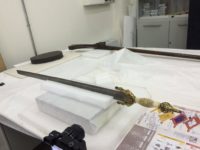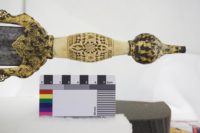 An exquisite sword designed by the finest metalworkers of Grenada and wielded by one of the last great military leaders in Muslim Spain has been digitized in 3D. It belonged to Ali Atar, Warden of Loja and Lord of Zagra, who has become a heroic figure with many tales of dubious accuracy told about his background, bravery and generosity.
An exquisite sword designed by the finest metalworkers of Grenada and wielded by one of the last great military leaders in Muslim Spain has been digitized in 3D. It belonged to Ali Atar, Warden of Loja and Lord of Zagra, who has become a heroic figure with many tales of dubious accuracy told about his background, bravery and generosity.
According to legend, Ali Atar started out as a trader in spices who climbed the ranks of Andalusian military leadership thanks to his skill in battle. He served Muhammad XII, Sultan of Granada, known by Christians as King Boabdil. Muhammad was also related to Ali Atar, having married Atar’s beautiful daughter Moraima whom he loved beyond all others. Muhammad’s reign was a tumultuous one riven by internecine warfare. Christian rulers took advantage of Grenada’s weakness to take Muslim cities and chip away at what was left of the last sultanate. The Sultan tried to flip the script and in April 1483, he and Ali Atar tried to take the Christian city of Lucena (Cordoba). The battle was lost and Ali Atar, then 90 years old, died in the fight, his trusty sword in hand.
Ali Atar’s long life and battlefield death mirrored the final century of Muslim rule in Spain. The Nasrid dynasty, rulers of the Emirate of Grenada, was the last Muslim dynasty in the Iberian Peninsula. Muhammed XII was captured at the Battle of Lucena and was only freed after he swore allegiance to Ferdinand II of Aragon and Isabella I of Castile. It was a meaningless allegiance as their Most Catholic Majesties had no interest in maintaining any kind of Islamic rule in Iberia, even under their ostensible suzerainty. In 1491, Ferdinand and Isabella besieged Grenada and on January 2nd, 1492, nine years after Ali Atar’s death, Muhammad XII surrendered the Alhambra palace to King Ferdinand II and Queen Isabella I and went into exile in Morocco.
 His sword’s fame outlived Ali Atar. Covered in gold and ivory, the sword was taken by Christian forces after Atar’s defeat at Lucena and is now one of the most precious treasures of the Toledo Army Museum. Researchers from the Polytechnic University of Valencia and Toledo company IngHeritag3D worked together to create a 3D model of this storied weapon.
His sword’s fame outlived Ali Atar. Covered in gold and ivory, the sword was taken by Christian forces after Atar’s defeat at Lucena and is now one of the most precious treasures of the Toledo Army Museum. Researchers from the Polytechnic University of Valencia and Toledo company IngHeritag3D worked together to create a 3D model of this storied weapon.
Its design and materials posed challenges to the digitizing team.
First they photographed the sword from many angles using a technique called photogrammetry. Then they overlapped all the images, drew planimetries (drawings of the meticulous filigree of the grip) and generated its 3D model.
“These techniques offer the possibility of valuing relevant pieces inside and outside museums, since three-dimensional modelling is prepared both for specialists -who can manipulate the piece virtually-, and for being shared publicly and interactively through the Internet,” says engineer Margot Gil-Melitón, co-author of the work.
Using a web viewer, any user can use their mouse to check an exact replica of the handle of this genet sword, a type of genuinely Nasrid weapon introduced in Al-Andalus by the Zenetas (Berber people from whom it takes its name). Ali Atar’s sword has a knob in the shape of a bulbous dome, an ivory fist carved with drawings and Arabic letters, and a golden arriax (sword grip) topped with zoomorphic figures.
To record the details of this fine ornamentation, the researchers have devised solutions that have facilitated the analysis of highly reflective materials and complicated geometries. Their workflow could also be applied to characterize other museum pieces.
Here’s the completed 3D model of the grip of the sword:
A fine bit of workmanship, but clearly it is a sword first and foremost.
Hardly can I decipher “Algae” on the upper ‘ivory fist’. However, Muhammad XII’s own –possibly likewise genuinely ‘Nasrid’– sword seems to have survived in the Musée de Cluny in Paris, a.k.a. the Musée national du Moyen Âge. It looks very similar in shape and size.
In ‘Hispania Baetica’ Vandals and Alans had passed through in the 5th century, followed by the kingdom of the Visigoths. Together with Africa
it was then reconquested by Belisarius in the Vandalic War of 533, until it temporarily was conquested by Ali and his friends, who then…
Terrible correction: “The clothing, shoes and swords of Muhammad XII (Boabdil) were given by the Catholic Monarchs as a gift to the alcaide de los donceles and the Count of Cabra. Currently the whole set is preserved at the Army Museum of Toledo” [i.e. not as was lead to believe in Paris]. The thing, however, is this one – Sorry for any confusion :confused:
Do you mean Granada?
Thanks for this post
Nice Blog for everyone. Everyone need to know this.